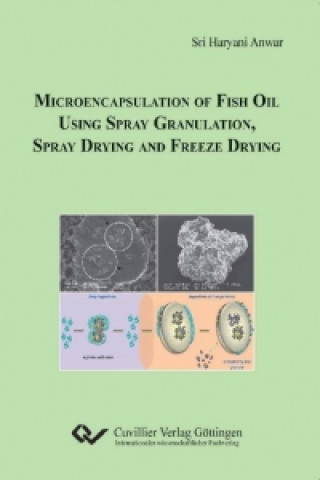
Versand
Kaufberater





Passt nicht? Macht nichts! Bei uns ist die Rückgabe innerhalb von 30 Tagen möglich
 Geschenkgutschein
In einem beliebigen Wert
Geschenkgutschein
In einem beliebigen Wert
Mit einem Geschenkgutschein können Sie nichts falsch machen. Der Beschenkte kann sich im Tausch gegen einen Geschenkgutschein etwas aus unserem Sortiment aussuchen.
Microencapsulation of Fish Oil Using Spray Granulation, Spray Drying and Freeze Drying
 Englisch
Englisch
 81 b
81 b
30 Tage für die Rückgabe der Ware
Das könnte Sie auch interessieren


The stability of microencapsulated fish oil prepared using various drying methods is investigated. In the preliminary study, two production processes, i.e., spray granulation (SG) and SG followed by film coating (SG-FC) are examined and compared. First, three types of fish oil (10/50, 33/22, and 18/12) based on the ratios of eicosapentaenoic acid (EPA) and docosahexaenoic acid (DHA) are used in the SG process. Each type of fish oil was emulsified with soybean soluble polysaccharide (SSPS) and maltodextrin to produce 25% oil powders. Second, a 15% film coating of hydroxypropyl betacyclodextrin (HPBCD) is applied to the SG granules. The powder stability against oxidation is examined by measurement of peroxide values (PV) and GC-headspace propanal after 6- weekĆs storage at room temperature (ż 21 żC) and at 3 - 4 żC. The results show that the coated powders have lower stability than uncoated powders and this indicates that the film coating by HPBCD ineffectively protected the fish oil as the coating process might have induced further oxidation. In the main research, emulsions of 33/22 fish oil are prepared with four combinations of matrices and microcapsules are produced by SG, spray drying (SD), and freeze drying (FD). The objective is to identify the most critical factors which determine powder stability and to further examine the superiority of the SG process compared to other drying processes. Oxidation parameters and analytical methods remain the same as in the preliminary study, but the storage time is extended to 8 weeks. The best matrices are a combination of 10% (w/w) SSPS and 65% (w/w) OSA-starch. Microencapsulation of 620 mg/g fish oil with these coating materials then dried by SG is able to produce fish oil powder having a very low propanal content and with a shelf life of five weeks at ż 21 żC. The ability of SSPS to form thick membranes at the oil/water interface and the role of both matrices to stabilize emulsion by steric repulsion are critical to prevent early formation of peroxides. The results of the present research indicate that instead of layering a single concentrated core, microcapsule formation by the SG process is actually started by agglomeration of seed particles. The seed particles are then covered by the growth of droplet deposition and the granule surface is coated by fine particles. This assumption is supported by scanning electron microscope (SEM) examinations which verify the raspberry-like microstructure of the final granules. Therefore, it can be assumed that the SG process produces ômultiple encapsulationsö granules and provides maximum protection to the oil droplets. Comparison of the SG, SG-FC, SD, and FD processes confirms that combination of matrices, drying temperature, microcapsule morphology, and processing time are among the most critical factors governing the stability. Exposure to high drying temperature or heat is proved to be a limiting factor for drying unstable emulsion. If a process does not apply high drying temperature, the particle morphology becomes a determining factor for product stability. The main contribution of this study is to provide in-depth evaluation of four different drying processes with comprehensive information on the drying mechanisms in relation to how they affect the stability of microcapsules. The amount of polyunsaturated fatty acids (PUFAs), fish oil quality, type of matrix, and their physicochemical characteristics are also discussed in this study.
Informationen zum Buch
 Englisch
Englisch


 Kontakt
Kontakt Wie einkaufen
Wie einkaufen



























